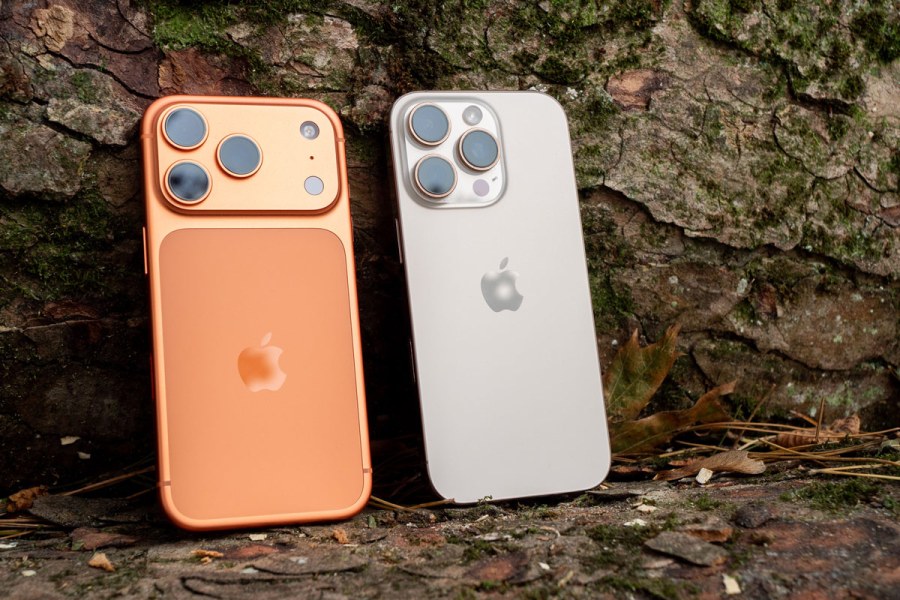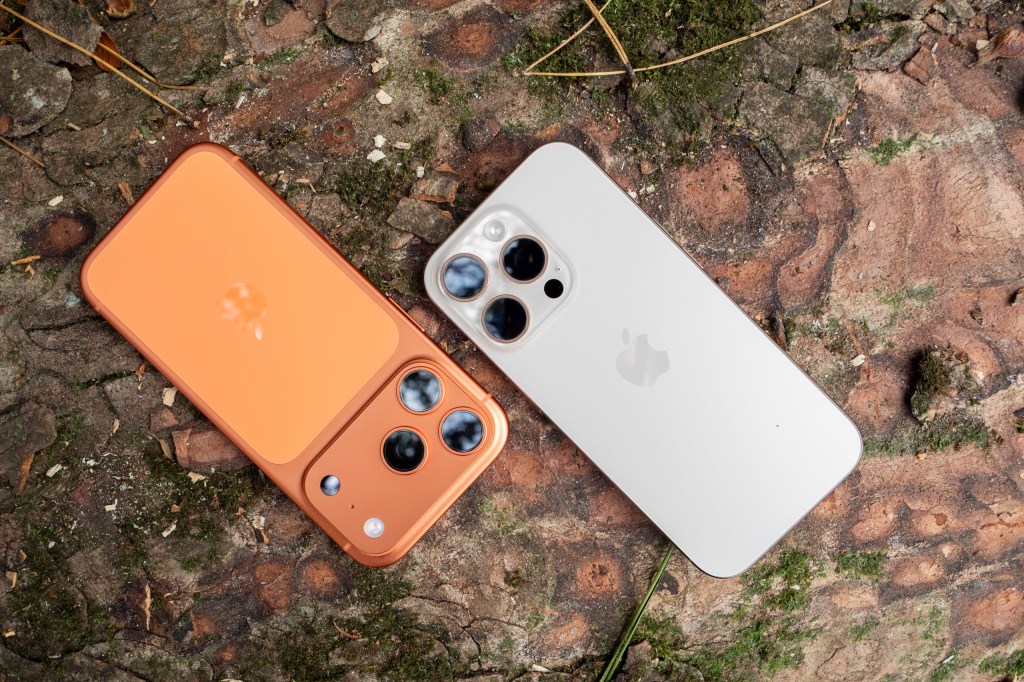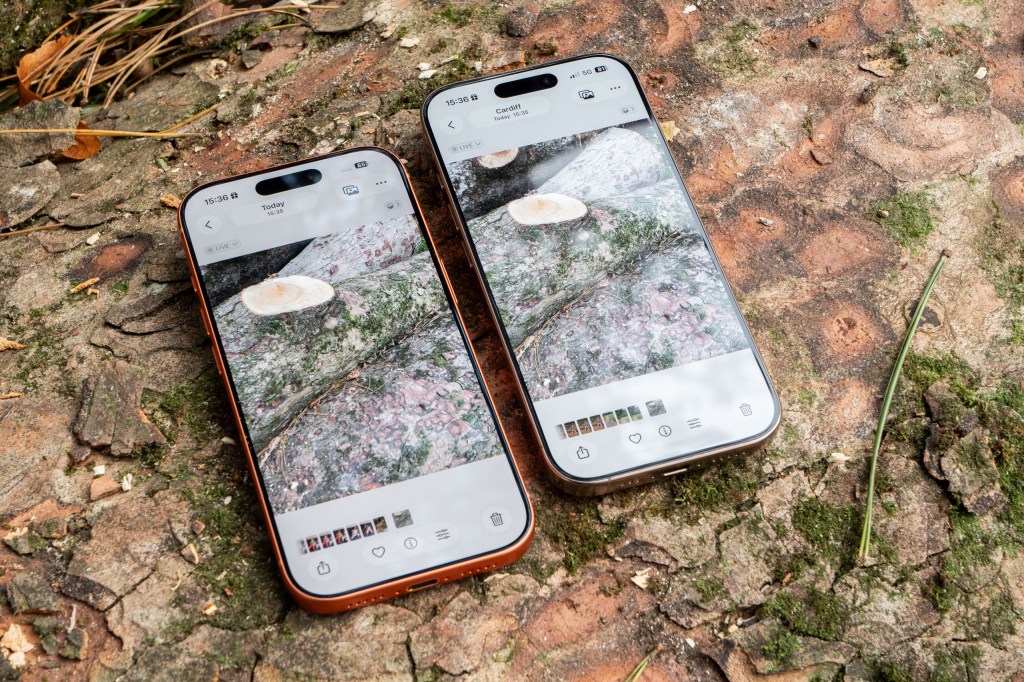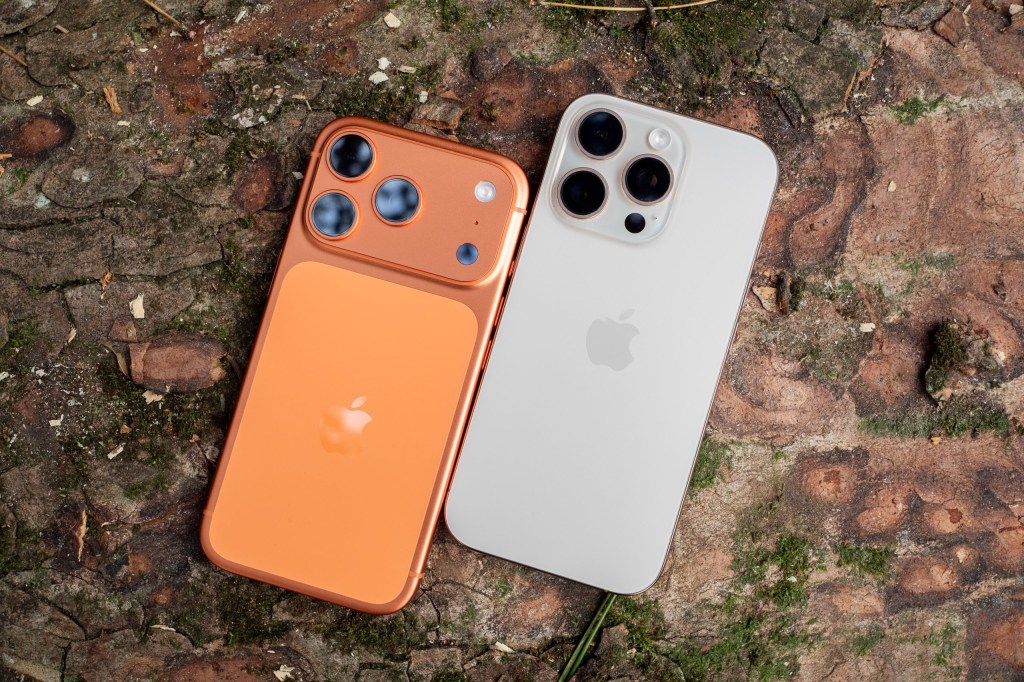Each year, Apple’s top-line iPhone makes it on to our list of the best smartphones for photographers, and the new iPhone 17 Pro is no different. However, how much of a difference is there between it and the previous model – do you actually need to upgrade, or would you be better off saving your hard-earned cash for something else?
The iPhone 17 Pro follows on from the iPhone 16 Pro and it’s fair to say that it doesn’t represent a huge upgrade. There are a couple of key differences, but for many, sticking with the phone they already have and waiting until the next model might be a good way to keep your wallet happy.
I’ve used both models at the same time in a variety of different shooting scenarios to see whether any of those upgrades are worth the upgrade – keep reading to find out more.
iPhone 17 Pro vs iPhone 16 Pro: Specs
If you have a look at specs table below, you can see how the two models compare. I’ve included specs that are most likely to be of interest to photographers, and bolded where there’s an improvement – as you’ll see there’s not a huge amount of bold to take note of in the left-hand column.
| iPhone 17 Pro | iPhone 16 Pro |
| 48MP f/1.78 main camera, OIS, 24MP output, 24mm | 48MP f/1.78 main camera, OIS, 24MP output, 24mm |
| 48MP f/2.2 ultrawide camera, 24MP output, 13mm | 48MP f/2.2 ultrawide camera, 12MP output, 13mm |
| 48MP f/2.8 4x telephoto camera, 24MP output, 100mm, 8x “optical quality” crop (12MP) | 12MP f/2.8 5x telephoto camera, 120mm |
| 18MP f/1.9 selfie camera with square sensor | 12MP f/1.9 selfie camera |
| 4K 120fps video, Dual Capture, Apple Log2, ProRes RAW, genlock support | 4K 120fps video, Apple Log |
| 6.3-inch XDR OLED Super Retina 2622 x 1206 pixels, 3000 nits max brightness, 120Hz Ceramic Shield 2 front and back, aluminium unibody | 6.3-inch XDR OLED Super Retina 2622 x 1206 pixels, 2000 nits max brightness, Ceramic Shield front, titanium frame |
| IP68 splash, water and dust resistant | IP68 splash, water and dust resistant |
| Apple Intelligence, A19 Pro Processor | Apple Intelligence, A18 Pro processor |
| 31 hour battery life, wireless and fast charging (40W) available | 27 hour battery life, wireless and fast charging (20W) available |
| 256GB/512GB/1TB storage | 128/256/512GB/1TB storage |
| 150 x 71.9 x 8.75mm, 204g | 149.6 x 71.5 x 8.25mm, 199g |
The two biggest differences – camera hardware wise at least – are to the telephoto lens and the selfie camera. The telephoto lens for the iPhone 17 Pro is now 48MP, like the other two lenses in the triple set up. It’s also got a bigger sensor. That said, it’s now only a 4x zoom, rather than a 5x, but, it does offer 8x “optical quality” which the iPhone 16 Pro doesn’t promise.
As for the selfie camera, Apple has finally increased the resolution there too, after years of using the same selfie camera on its devices. More interestingly is the fact that it’s got a square sensor, which enables you to shoot in whichever orientation you like (landscape or portrait) without having to physically turn the device.
If you’re an advanced video user, you might be interested in the new pro-level video specs that the 17 Pro offers. You now get ProRes RAW, AppleLog 2 and Genlock support. If you don’t know what any of that means, you probably don’t need to, but essentially they all give you much greater flexibility in both recording and editing video from your phone – content creators who want that kind of capability may feel it’s worth the upgrade, but many will likely be completely oblivious this stuff even exists, much less actually use it.
Something that might be more broadly appealing is the new Dual Capture option. With this you can record video using both the front and rear cameras at the same time. You might feel inclined to record your travels, with a little box with your face in commentating on it – each to their own.
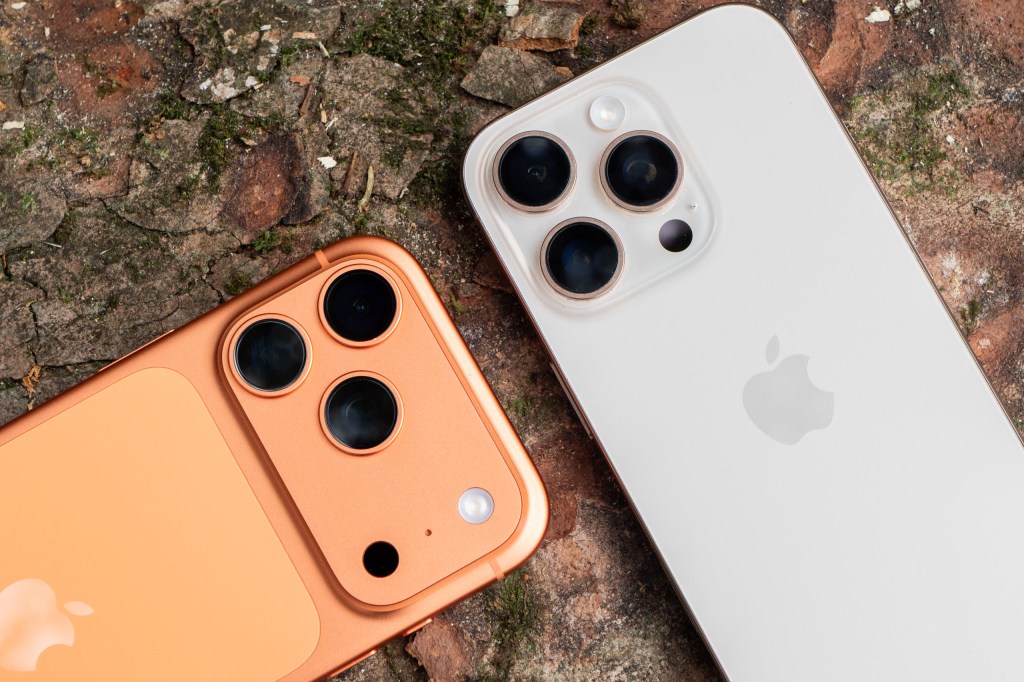
There are other non-camera differences to be found too. Design wise, the iPhone 17 Pro has a new “camera plateau” – essentially a bar across the back of the phone which houses not only the camera lenses, but also some other things, such as the antennae. The knock-on effect of this is that there’s now room for a larger battery, giving you a better battery life than before. You can also fast charge at 40W, rather than 20W.
Apple has gone back to using aluminium for the iPhone 17 Pro, rather than titanium for the iPhone 16 Pro. Now, titanium is a stronger material than aluminium, but, the 17 Pro has a “unibody” design so it still maintains excellent strength. It’s also got an improved screen, which now has Ceramic Shield 2, promising 3x better scratch resistance and 3000 nits brightness. There’s also Ceramic Shield on the back too – overall the 17 Pro should be tougher.
Different colours are available for the 17 Pro, including the new divisive “Cosmic Orange” as seen in my pictures. I can’t deny that it’s vibrant, but whether you like it or not is another matter.
The iPhone 17 Pro should be faster, as it has the A19 Pro processor, but, unless you’re consistently performing high-power tasks (for example gaming or editing 4K video), it’s probably not something most will notice.
iPhone 17 Pro vs iPhone 16 Pro: Image Quality
I used both the iPhone 17 Pro and the iPhone 16 Pro to take photos in a variety of different shooting conditions to give me the opportunity to directly compare the two. In the sliders below, the iPhone 17 Pro is always on the left, and the iPhone 16 Pro is always on the right.
GENERAL


In my tests, the 1x lens on both models appear to be pretty much identical. Here, the scene looks the same from both models, even when zooming in to look at details on a big screen. This isn’t a huge surprise as it seems that the specification is the same between the two.
ULTRAWIDE


Again, the ultra-wide lenses / cameras here have the same specification. Therefore, it’s no surprise to see that they have performed the same, with the same level of detail in both.
2x


Unsurprisingly, there’s also no real difference here. The 2x uses the central portion of the 1x sensor.
4x (17 Pro) / 5x (16 Pro)


Here we can see more of a difference. The 17 Pro is a wider angle, at 4x / 100mm equivalent, while the 16 Pro is 5x zoom / 120mm equivalent. However, interestingly, if you zoom in, it looks like the iPhone 16 Pro is actually more detailed, despite having the lower resolution of the two (at 12MP rather than 24MP). This is quite picky however, and the overall effect of the two is very similar. You could argue that 4x (17 Pro) is a more sensible zoom length, but you could also say that you’d prefer the optical zoom to be longer (16 Pro).
8x “optical quality” zoom


The iPhone 17 Pro is the first iPhone to offer the 8x “optical quality” option. Similarly to the 2x option, it uses the central portion of a sensor, this time using the telephoto lens. The results are pretty good, with a good level of detail from the 12MP image. You can shoot at 8x with the iPhone 16 Pro too, but it’s a more straightforward digital zoom and is not as crisp or clear as the 17 Pro – though in fairness the difference isn’t huge, especially if you’re only looking at the images on a small screen like your phone.
MACRO


The macro setting works by using the ultrawide lens, cropping into the middle. It’s therefore no huge surprise that these images are more or less the same.
Low-light Performance
1x


When light is low, the 1x lens from both models produces very similar results. There’s slightly more detail in the 17 Pro’s image, but only really if you’re looking for it on a large screen. Both have produced a good image, which shows more than was really possible to see with the naked eye.
Ultrawide


It’s a similar story with the ultrawide lens – there’s a touch more detail from the 17 Pro. This is perhaps due to the better processing from the A19 Pro processor.
4x/5x


Interestingly, here the 5x lens produces the better shot. However, this is because the 17 Pro has elected to use the 1x lens and crop, rather than use the telephoto lens – this is not something you can control manually. The 16 Pro used the telephoto lens.
PORTRAIT


Here the results are very similar, but there’s perhaps very slightly nicer colours from the 17 Pro.
SELFIE


As I’d expect, although the selfies are fairly similar, there’s a bit more detail visible from the iPhone 17 Pro. What’s more useful here is the ability to record either in landscape or portrait without turning the phone – a feature which is more useful than perhaps it sounds.
iPhone 17 Pro vs iPhone 16 Pro: Price and Value for Money
The iPhone 17 Pro starts at $1099/£1099 for the 256GB model, rising to $1299/£1299 for the 512GB variant and topping out at $1499/£1499 for the 1TB option.
You could get hold of an iPhone 16 Pro for $999/£999, however that was for 128GB of data, which isn’t an option for the iPhone 17 Pro – therefore the prices have stayed the same.
Apple no longer directly sells the iPhone 16 Pro, but you can get it from plenty of third party sellers, but, brand new it’s often the same price as the iPhone 17 Pro – in which case you may as well get the newer model.
It’s possible however to find good second-hand deals, so you might want to consider looking in the used market if you’re keen to save cash.
If you already have an iPhone 16 Pro, you’ll save yourself a tonne of cash by skipping the 17 Pro altogether – which is what I’d probably be inclined to do. With iPhones, it’s almost always worth waiting at least two generations between upgrades to get the best value for money.
Verdict
Is the iPhone 17 Pro better than the iPhone 16 Pro? Well, yes, but not that much.
There’s a couple of upgrades to the camera, but in terms of image quality, the differences between the two are pretty minimal. You can see from my examples that both produce great shots – so if you’re expecting a big leap in image quality then you’ll be disappointed.
Probably the biggest improvements come from elsewhere – for example the brighter screen and the improved battery life. And, in fairness, if you’re an advanced video creator, there’s some decent upgrades to enjoy here too.
If you’re already the owner of an iPhone 16 Pro, I’d almost certainly stick with it. If you’re coming from an older model, I’d consider upgrading to the iPhone 16 Pro if you can find it for cheaper – perhaps second hand – than the iPhone 17 Pro, too.
Overall, the iPhone 17 Pro of course represents an upgrade from the predecessor, but for photographers at least, it’s a fairly gentle one.
Related reading:
- iPhone 17 review: is this the iPhone you should buy?
- iPhone 17 Pro review: Apple’s best camera, but is it worth upgrading?
- iPhone 16 Pro review: small screen, maximum zoom
- iPhone 15 Pro Review – the perfect balance?

